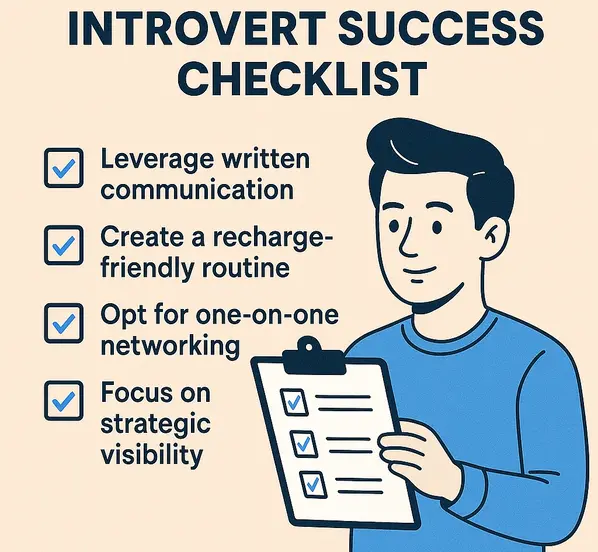Introduction
In a world that often celebrates extroversion, introverts can sometimes feel overlooked in professional environments. From open-plan offices to high-energy networking events, the modern workplace can present unique challenges for those who thrive in solitude and introspection. But being an introvert is not a limitation—it’s a different kind of strength. With the right strategies, introverts can not only survive but truly thrive in their careers.
In this comprehensive guide, you’ll discover how to harness your natural tendencies as an introvert to achieve workplace success. We’ll explore actionable tips, highlight common pitfalls, share real-life examples, and offer tools to help you excel—whether you’re job hunting, aiming for a promotion, or simply seeking more ease in daily interactions at work.
Table of Contents
1. Understanding Introversion in the Workplace
Before we dive into strategies, it’s important to understand what introversion really means. Contrary to popular belief, introverts are not necessarily shy or anti-social. Rather, they gain energy from solitude and often prefer meaningful conversations over small talk. They tend to be more reflective, observant, and measured in their approach to social interaction.
Key Characteristics of Introverts:
- Prefer one-on-one or small group interactions
- Thrive in quiet environments
- Reflect deeply before speaking or acting
- Value meaningful work over constant visibility
- Are often more productive working independently than in group settings
Why Introverts Excel at Work:
Introverts often possess key qualities that are incredibly valuable in the modern workplace. They’re:
- Strong problem solvers due to their analytical nature
- Focused and detail-oriented, which makes them excellent in roles requiring precision
- Effective listeners, leading to stronger interpersonal relationships
- Thoughtful communicators who consider the impact of their words
Organisational Benefits of Embracing Introversion:
Companies that recognise and support introverts benefit from improved productivity, higher job satisfaction, and more balanced team dynamics. Encouraging diverse personality types fosters innovation and inclusivity, creating a workplace where everyone can thrive.
Search-Optimized Insight:
Introverts bring unique value to the workplace. By understanding their strengths, both employees and employers can foster a more inclusive and productive environment.

2. Step-by-Step Guide to Thriving at Work
Step 1: Embrace Your Introvert Strengths
Start by acknowledging the power of your natural tendencies. Use your deep thinking skills to solve complex problems and bring innovative ideas to the table. Position yourself as the go-to person for thoughtful, well-researched insights. Accept that being reflective, cautious, and intentional is an asset. Write down your key strengths and revisit them whenever you feel uncertain.
Step 2: Create an Introvert-Friendly Workspace
Personalising your environment can help reduce mental fatigue. Use noise-cancelling headphones to limit distractions, or negotiate for a quieter corner in an open-plan office. If you’re remote, create a calming home workspace with natural lighting, comfortable seating, and minimal clutter. Even minor adjustments, like using ambient sound apps or blocking out time for focused work, can greatly improve concentration and comfort.
Step 3: Prepare for Social Interactions
Preparation can reduce anxiety in meetings, presentations, and networking events. Write down questions in advance, rehearse key talking points, and set small, achievable social goals. If possible, review attendee lists or agendas before events. This not only makes you feel more confident but enables deeper, more meaningful connections during interactions.
Step 4: Set Boundaries
Protect your energy by clearly defining your limits. Politely decline unnecessary meetings or opt for emails when appropriate. Use calendar tools to block out focus time, and don’t hesitate to schedule breaks to recharge. Practising assertiveness in a respectful way can also build professional credibility and encourage others to respect your work style.
Step 5: Communicate Strategically
Introverts often excel in written communication. Use this to your advantage—send well-thought-out emails, craft detailed proposals, and provide clear documentation. If you’re uncomfortable speaking spontaneously, ask to contribute asynchronously. This approach not only showcases your communication skills but also ensures your ideas are thoroughly considered.
Step 6: Seek Aligned Opportunities
Pursue job roles that match your personality and working preferences. Careers in writing, data analysis, programming, research, and design often allow for autonomy and deep focus. Explore opportunities that value thought leadership and quality over quantity. Use personality assessments and job-fit tools to identify suitable roles.
Helpful Tools:
- Evernote for reflective journaling and idea organisation
- Trello or Notion for managing independent projects
- Slack (with customised notifications) for structured communication and asynchronous updates
3. Common Pitfalls and How to Avoid Them
Pitfall 1: Avoiding All Social Interaction
While it’s tempting to stay in your comfort zone, too much isolation can lead to feelings of disconnection. Try to engage in one-on-one meetings, mentorship opportunities, or join professional online communities. Build relationships gradually through consistent but low-pressure interactions.
Pitfall 2: Not Speaking Up in Meetings
Introverts often hold back, especially in larger meetings. This can lead to missed opportunities for recognition or influence. Prepare your talking points in advance and commit to sharing one insight or question during each meeting. If you’re uncomfortable speaking up in real time, follow up afterward with a thoughtful email summary.
Pitfall 3: Overcommitting to Avoid Conflict
To avoid confrontation, introverts may say “yes” to every request. Over time, this can lead to burnout. Learn to assert your boundaries by using diplomatic language, such as, “I’d love to support this, but I’m currently focused on completing another project. Can we revisit this next week?”
Pitfall 4: Neglecting Self-Advocacy
Self-promotion doesn’t have to be boastful. Document your accomplishments and contributions regularly. Keep a “brag file” with key metrics, positive feedback, and completed projects. Share these in performance reviews or team check-ins to ensure your value is recognised.

4. Real-Life Examples of Introvert Success
Case Study 1: Emma, Data Analyst in Manchester
Emma struggled with the social demands of her open-plan office. After speaking with her manager, she negotiated one remote day per week and adjusted her schedule to avoid peak office hours. She also began using Slack for asynchronous communication, reducing the need for impromptu discussions. Her productivity and job satisfaction improved significantly, and her manager implemented similar changes team-wide.
Case Study 2: Tom, Junior Software Developer
Tom felt invisible during meetings and hesitant to share ideas. After encouragement from a mentor, he began writing a weekly team newsletter that included project updates, code tips, and shout-outs. His initiative quickly gained recognition, and he was invited to contribute to larger cross-department projects. His confidence and professional presence grew with every edition.
Case Study 3: Priya, HR Coordinator in London
Priya found traditional networking events overwhelming. Instead of attending large mixers, she initiated a series of small, themed “lunch and learn” sessions within her company. These intimate gatherings allowed for deeper conversations and built her internal network. Her leadership in organising these sessions led to a promotion and expanded responsibilities.
What We Learn:
- Real change often comes from incremental, consistent steps.
- Leveraging introverted strengths—like written communication and reflective planning—can have significant impact.
- Customising your approach to work and social interaction enhances both productivity and fulfilment.
5. Recommended Tools and Resources
Books:
- Quiet by Susan Cain – A cornerstone resource that explores the power of introverts and how to leverage their strengths.
- The Introvert Advantage by Marti Olsen Laney – Offers scientific insights and practical tools to manage social energy effectively.
Websites:
- Quiet Revolution – Advocacy, stories, and strategies specifically for introverts.
- Myers-Briggs Foundation – Offers personality assessments and frameworks to better understand yourself and others.
Templates:
- Networking Prep Sheet:
- List 3 key people to connect with
- Write 5 conversation starters
- Prepare 3 key points of value you can contribute
- Workday Recharge Plan:
- Morning: 10-minute focus meditation
- Midday: Solo lunch break
- Afternoon: Quiet block for deep work
- End of day: Journal one success from the day
6. Conclusion & Call to Action
Introverts have a vital role to play in today’s workplace. With introspection, strategy, and self-awareness, you can design a career path that’s both successful and authentic. Don’t let outdated stereotypes hold you back—embrace your introversion as a superpower.
Ready to take the next step?
- Explore more guides at WhatJobs Career Advice
- Subscribe to our newsletter for tailored career insights
- Need personalized help? Contact our career coaching team today
Remember: thriving at work isn’t about being the loudest in the room—it’s about being the most authentic version of yourself. And that’s something introverts do best.
Frequently Asked Questions (FAQs)
How to survive in the workplace as an introvert?
To survive—and thrive—as an introvert at work, focus on leveraging your strengths like deep focus, listening, and strategic thinking. Create a quiet workspace, set clear boundaries, and use written communication to express ideas. Tools like Notion and Slack can support asynchronous collaboration. Preparing for interactions in advance helps reduce social fatigue. Research, like Susan Cain’s work in Quiet, shows introverts succeed when they honour their energy rhythms and find alignment between their roles and personal strengths.
Can introverts be successful in the workplace?
Absolutely. Introverts excel in roles that value thoughtfulness, analysis, and autonomy. Careers in writing, programming, data analysis, and research often favour introverted strengths. Many successful leaders, such as Bill Gates and Warren Buffett, identify as introverts. They’ve built influence through strategic thinking and strong execution, not charisma alone. Employers increasingly recognise the value of diverse work styles, making it easier than ever for introverts to succeed on their own terms.
Do introverts struggle in the workplace?
Introverts may face challenges like overstimulation in open offices or pressure to engage constantly. However, with self-awareness and strategy—such as preparing for meetings, setting boundaries, and using digital tools for communication—these struggles can be minimized. A 2023 LinkedIn study found that companies offering flexible workspaces saw higher engagement from introverted employees. By focusing on strengths like deep work and empathy, introverts can thrive despite initial hurdles.
How can an introvert be more visible at work?
Introverts can increase visibility by sharing their expertise through written channels like newsletters, detailed emails, or team wikis. Volunteering for projects that match their strengths or starting small internal initiatives also builds recognition. Follow up verbally shared ideas with well-crafted summaries to highlight thought leadership. As seen in our case study, Tom used a weekly email digest to showcase his value—earning respect and greater responsibilities without needing to dominate meetings.






